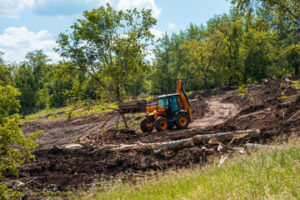Land Clearing Buda TX is an essential step in preparing a site for construction or agricultural use. It involves the removal of trees, shrubs, rocks, and other obstructions from a piece of land. This process creates a clean and stable foundation for future projects. Proper land clearing enhances soil quality and drainage, improving overall land productivity.

Different methods of land clearing are used based on the type of vegetation and soil conditions. Manual clearing involves using hand tools to remove smaller plants and debris. Mechanical clearing employs heavy machinery like bulldozers and excavators to handle larger trees and rocks. Controlled burning is sometimes used to clear dense vegetation, but it requires careful monitoring to prevent environmental damage.
Environmental impact is a major consideration when planning land clearing. Removing vegetation can disturb local ecosystems and lead to soil erosion. Responsible clearing practices, such as selective cutting and replanting, help minimize environmental disruption. Proper drainage and erosion control measures prevent long-term damage to the land.
Soil health is affected by the land clearing process. Removing surface vegetation can expose soil to erosion and nutrient loss. Mulching and soil conditioning help restore fertility and support new plant growth. Retaining some native vegetation can protect the soil and maintain biodiversity.
Land clearing is essential for expanding agricultural operations. Clearing overgrown or neglected land increases available planting space and improves crop yields. Proper grading and soil preparation create ideal growing conditions. Farmers often rotate crops and use cover crops to maintain soil health after clearing.
Construction projects rely on land clearing to establish a stable foundation. Removing rocks and debris ensures even ground for building structures. Grading and compacting the soil improve drainage and stability. Clear land allows for easier access to construction equipment and materials.
Land clearing can also improve land value and usability. Removing unwanted vegetation increases the aesthetic appeal of a property. Open land creates opportunities for recreational use, such as hiking trails and park spaces. Landowners can also increase property value by making land more accessible and functional.
Wildlife management is a key factor in land clearing decisions. Removing vegetation can disrupt animal habitats and migration patterns. Establishing buffer zones and wildlife corridors helps preserve local ecosystems. Responsible land clearing practices protect biodiversity and prevent long-term ecological damage.
Heavy machinery plays a significant role in land clearing efficiency. Bulldozers, excavators, and mulchers quickly remove large obstacles. Skilled operators ensure precise and controlled clearing without damaging surrounding areas. Advanced equipment with GPS technology improves accuracy and reduces waste.
Mulching and composting cleared vegetation provide environmental benefits. Shredded plant material enriches the soil and improves moisture retention. Composting organic debris reduces waste and supports sustainable land management. Reusing natural materials promotes a healthier ecosystem.
Permits and regulations govern the land clearing process. Local authorities often require environmental assessments before granting permits. Zoning laws and land use regulations influence the extent and methods of clearing allowed. Compliance with legal requirements ensures a smooth and lawful clearing process.
Reforestation and land rehabilitation follow many clearing projects. Planting native species helps restore ecological balance. Erosion control measures, such as planting ground cover and installing barriers, prevent soil degradation. Sustainable land management ensures long-term productivity and environmental health.
Land clearing for infrastructure development requires strategic planning. Roads, utilities, and public facilities need stable and accessible land. Clearing routes for transportation and communication networks supports economic growth. Infrastructure projects benefit from efficient and environmentally responsible clearing methods.
Fire risk management is a consideration in land clearing. Removing dry vegetation and deadwood reduces fire hazards. Firebreaks created during clearing projects prevent the spread of wildfires. Controlled burns, when properly managed, reduce fuel loads and improve forest health.
Land clearing for residential development increases housing availability. Preparing lots for construction creates new neighborhoods and communities. Proper land grading ensures stable foundations and effective drainage. Landscaping and green spaces improve residential appeal and environmental quality.
Economic benefits from land clearing extend to multiple industries. Agriculture, construction, and real estate all rely on cleared land for development. Increased land use supports job creation and local economies. Responsible land management ensures long-term economic and environmental sustainability.
Land clearing techniques continue to evolve with technological advancements. Precision clearing with GPS and automated equipment reduces waste and improves accuracy. Eco-friendly methods, such as selective cutting and mulching, minimize environmental impact. Innovations in land management support more sustainable development.
Seasonal and weather conditions affect land clearing projects. Wet or frozen ground can complicate machinery use and increase costs. Planning clearing activities during dry and stable weather improves efficiency and reduces environmental disruption. Monitoring weather patterns ensures safe and effective clearing.
Community involvement is important in large-scale land clearing projects. Public input helps identify environmental and social concerns. Transparent communication with local stakeholders builds trust and support. Addressing community feedback improves project outcomes and acceptance.
Land clearing enhances land productivity and usability when done responsibly. Removing overgrowth and debris creates opportunities for agriculture, construction, and recreation. Sustainable clearing methods protect soil health and biodiversity. Planning and environmental considerations ensure long-term benefits and balanced development.
Rehabilitation and maintenance follow most land clearing projects. Ongoing erosion control and vegetation management protect the cleared land. Monitoring soil health and drainage ensures long-term stability. Regular maintenance supports the success of agricultural and construction projects.
Land clearing remains a crucial step in land development and management. Proper planning and execution create safe, stable, and productive land. Sustainable methods preserve environmental health and protect natural resources. Responsible land clearing balances development needs with ecological preservation.